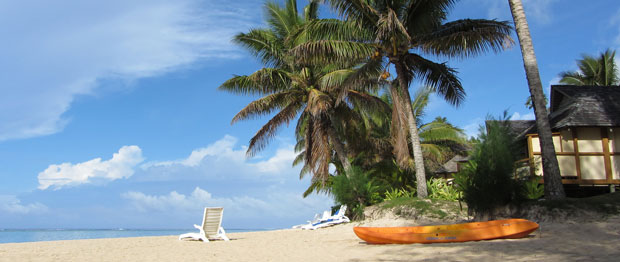
The Cook Islands are located in the middle of the Pacific Ocean, a 240 square meter tropical paradise. We’ll save you time and money on your trip to the Cook Islands with these top tips to help you before and during your stay.
Before your trip
Even though the Cook Islands are administered by New Zealand, Safe Travel recommends that travellers to the Cook Islands have comprehensive travel insurance including medical evacuation by air. Get a quote to cover your trip before you leave.
All flights arrive to Rarotonga—the capital. The best and most efficient way to reach the other islands is by Air Rarotonga. There are even sightseeing flights and daytrips if you don’t want to commit to staying on other islands.
While other Pacific islands have reliable and relatively inexpensive internet access, internet access is really expensive in the Cook Islands. Most internet cafes also charge by the minute or hour and service is quite slow, increasing the charge for any task you are trying to accomplish. Therefore, if you do need to check in, limit yourself to a few status updates, and don’t plan on uploading photos while you’re on the islands. An extra photo card or two will allow you to capture all your memories without incurring large data charges.
On arrival
You’ll need to prove that you have a place to stay and enough funds to sustain yourself, so you have to make arrangements in advance. Camping is not allowed, so that’s not an option.
Don’t pack any fruits or vegetables—they’ll be taken when you clear customs at Rarotonga Airport. Meat from New Zealand is permitted, as is two litres of spirits or wine per person.
If you’re taking the bus from the airport, there is an extra charge for your backpack. Once you’re settled in, try to carry a smaller daypack to avoid the surcharge.
During your stay
Bring (and wear) beach shoes. There can be stonefish and blue bottles in the lagoons, plus the coral can be sharp. Shuffle when you walk in the water, and avoid going completely barefoot.
Buy local handicrafts like black pearl jewellery and hats from woven coconut palms as wonderful and unique souvenirs.
You can rent motor scooters or cars to get around, but you’ll find that diesel is quite expensive. Most visitors enjoy walking in the tropical landscape. In the heat of the day, the bus is a better option.
If whale watching is on your wish-list, plan your trip from July-October. The whole territorial waters around the islands-two million square km of ocean are designated as a whale sanctuary. Never approach a whale with your boat, jet ski or kayak (though they may be curious and approach you). If that’s a little too 'up-close' for your preference, there are good whale watching spots on Main Street.
Learn a few words of Maori. While everyone speaks English, Cook Islands Maori is the official language of the Cook Islands. Kia Orana.
Departing
There is no longer a departure tax collected at the airport (no need to save that NZ$55) as it is now included in your airline ticket fees.
Use your flight home to being planning your return visit.



